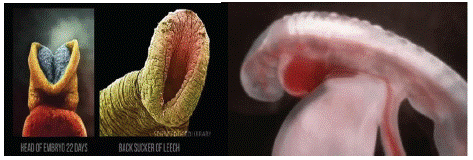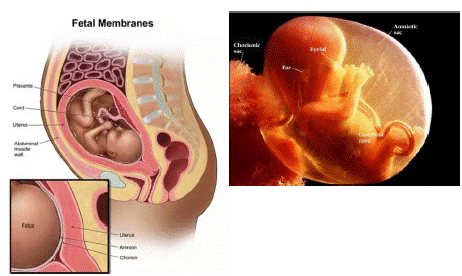
Editorial
Austin J Anat. 2024; 11(1): 1113.
Embryogenesis – A Journey of Life
MD Ejaz Alam*; Neha Fatima; Samreen Fatima
GMC, Srinagar, India
*Corresponding author: Md Ejaz Alam, GMC, Srinagar, India. Email: ejazpmch@gmail.com
Received: October 21, 2024; Accepted: November 07, 2024 Published: November 14, 2024
Abstract
Embryogenesis, the process of human development from fertilization to birth, involves several stages such as the formation of bones, muscles, and facial features, which modern science has detailed. Remarkably, the Quran described many of these stages over 1,400 years ago. The Quran accurately identifies the male sperm as determining the baby’s sex, describes the development of the embryo in stages, and mentions the fetus being protected in “a triple darkness,” referring to the layers surrounding it. The Quran also touches on the changes in the womb lining, the protective amniotic fluid, and the formation of bones and muscles, all of which align with modern scientific findings. This shows a striking harmony between ancient scripture and contemporary embryology.
Keywords: Sperm; Embryo; Bone and muscles
Introduction
Embryogenesis is a remarkable process by which a fertilized egg develops into a fully formed human being. Modern science, through careful study of genetics and developmental biology, has revealed the intricate mechanisms of this process, but interestingly, many aspects of human embryonic development were alluded to in the Quran more than 1,400 years ago. This chapter will explore the stages of embryogenesis, focusing on how these stages are reflected in both contemporary scientific findings and Quranic verses.
Fertilization: The Union of Sperm and Egg
Human development begins with fertilization, where a sperm cell from the male combines with an egg cell from the female. Each of these cells contributes 23 chromosomes, resulting in a total of 46 chromosomes in the newly formed zygote. The sex of the baby is determined by the type of sperm that fertilizes the egg. If the sperm carries an X chromosome, the result will be a female (XX); if it carries a Y chromosome, the result will be a male (XY). Thus, it is the male sperm that determines the sex of the baby [1].
Quranic Insight: This process is hinted at in Quran 53:45-46, which states, “And He creates pairs, male and female, from sperm emitted.” The Quran clearly refers to sperm (nutfa) as the determinant of the baby's sex. Modern science confirms that it is indeed the male's sperm that carries either the X or Y chromosome, deciding whether the child will be male or female. Remarkably, the verse number is 46, the same as the total number of chromosomes in a human cell [2].

Cleavage: Rapid Cell Division
Once fertilization occurs, the zygote undergoes multiple rounds of cleavage, a process of rapid cell division without increasing in size. The zygote forms a cluster of cells known as the morula, which eventually develops into a blastocyst, a hollow structure containing an inner mass of cells that will give rise to the embryo.
Implantation: Attachment to the Uterus
Around the sixth or seventh day after fertilization, the blastocyst implants itself into the lining of the uterus. This implantation is essential for the embryo’s survival, as it begins drawing nutrients from the mother to support its growth [3].
Quranic Insight: In the Quran, this stage is described as ‘Alaqah (a leech-like entity). The verse Quran 23:14 states, “Then We made the drop into a leech-like structure (Alaqa),” accurately describing how the embryo attaches itself to the uterine wall, resembling a leech clinging to its host [4].

Gastrulation: Formation of Germ Layers
Following implantation, the cells of the blastocyst begin to differentiate into three primary germ layers during a process called gastrulation. These layers—ectoderm, mesoderm, and endoderm— will form all the organs and tissues of the body [5].
Neurulation: The Nervous System Begins
By the third week of development, the neural tube forms from the ectoderm, which will later develop into the brain and spinal cord, marking the beginning of the nervous system [6].
Somitogenesis: The “Mudgha” Stage
At around the sixth week, the embryo’s vertebrae begin to take shape in a process known as somitogenesis. At this stage, the developing vertebrae and surrounding tissues have a chewed, segmented appearance [1].
Quranic Insight: This stage is described in the Quran as Mudgha, meaning a chewed lump. Quran 23:14 states, “Then We made the leechlike structure into a chewed lump (Mudgha),” perfectly describing the appearance of the embryo at this point in its development [4].

Organogenesis: Formation of the Skeleton and Muscles
The process of organogenesis begins soon after somitogenesis. The skeleton and muscles start to form, with the bones initially appearing as cartilage. The first bone to ossify (turn into actual bone) is the mandible (jawbone), followed by the development of muscles.
Scientific Insight: Studies on Meckel’s cartilage reveal that the jawbone ossifies around day 41 of embryonic development, and the associated muscles attach around day 44 [7] . This process begins with the formation of bones, followed by the growth of muscles—a sequence accurately described in the Quran.
Quranic Insight: Quran 23:14 further states, “Then We developed the lump into bones, and We clothed the bones with flesh.” This reflects the accurate order of human development, where the skeleton forms first, and then muscles (flesh) surround the bones [4].
The Development of Facial Features
Between the second and third months of development, the embryo begins to develop distinct facial features. Initially, the fetus is featureless, but as the bones and muscles mature, the face starts to take form.
Scientific Insight: Research from Penn State University indicates that facial features begin forming during the second and third months, aligning with the Quranic description of human development [8].
Quranic Insight: The Quran reflects this process in Quran 22:5, which states, “…then from a lump of flesh, featureless and with features (Khilka Mukhallaka),” describing the fetus as going through stages where it is both featureless and then develops features. This is consistent with modern embryology, where the facial features gradually form after the initial stages of bone and muscle development.
Changes in the Womb Lining
During the menstrual cycle, the thickness of the endometrium (the womb lining) changes dramatically, increasing from about 2 mm to 16 mm to prepare for possible implantation of a fertilized egg. If no implantation occurs, the lining is shed during menstruation.
Quranic Insight: In Quran 13:8, it is stated, “Allah knows what every female bears, and every decrease and increase to the wombs.” This verse accurately describes the changes in the thickness of the womb lining, which fluctuate based on hormonal signals throughout the menstrual cycle.
Protection of Fetus
The fetus is protected by three distinct layers during its development: the amnio-chorionic membrane, the uterus, and the abdominal muscle wall. While the fetus receives everything it needs—nutrients, oxygen, and even sound from the outside world—it remains in complete darkness because light cannot penetrate these layers. In Quran 39:6, the verse describes the creation of the fetus inside "a triple darkness", which aligns with the three protective layers we know today. This profound description highlights the protective environment in which the fetus develops [9].

/div>
Throughout the pregnancy, the fetus is surrounded by amniotic
fluid, which provides protection and facilitates the exchange of
nutrients. The amniotic fluid is primarily composed of water,
especially in the early stages of pregnancy.
Scientific Insight: The amniotic fluid, commonly referred to as
“water,” plays a crucial role in cushioning the fetus and ensuring its
growth and development. By the 12th to 14th week, this fluid contains
important proteins, carbohydrates, lipids, and electrolytes [10].
Quranic Insight: The Quran refers to the creation of humans from
water in Quran 86:6, which states, “He was created from gushing
water (Ma-e).” The reference to water here can be understood as a
description of the amniotic fluid, which surrounds the fetus and
provides it with essential nourishment.
Conclusion
Embryogenesis is a complex and miraculous process that starts
with fertilization and culminates in the formation of a fully developed
human being. Modern science has revealed the intricacies of this
process, from the determination of the baby’s sex by the sperm to
the development of bones, muscles, and facial features. What is
particularly remarkable is how these stages of development were
described in the Quran over 1,400 years ago, in a manner consistent
with what we know today. This convergence of ancient knowledge and modern scientific discovery highlights the depth and precision
with which human development is portrayed both in the Quran and
in contemporary biology. The Quran, revealed over 1,400 years ago,
is considered to be the divine word of Allah. It contains guidance not
only on spiritual and moral matters but also on various aspects of the
natural world from basic arithmetic’s to the most advanced topics
in astrophysics, including human physiology and embryological
development.
References
- Gilbert SF. Developmental Biology. 6th edition. Sunderland (MA): Sinauer
Associates; 2000. Chromosomal Sex Determination in Mammals. 2000.
- https://www.quranwow.com/#/ch/53/t1/ar-allah/t2/en-itania/a1/alafasy-64/a2/
none/v/45
- https://www.msdmanuals.com/home/women-s-health-issues/normalpregnancy/
stages-of-fetal-development#:~:text=About%206%20days%20
after%20fertilization%2C%20the%20blastocyst%20attaches%20
to20the,3%20to%204%20cells%20thick.
- https://www.quranwow.com/#/ch/23/t1/ar-allah/t2/en-itania/a1/alafasy-64/a2/
none/v/14
- Muhr J, Arbor TC, Ackerman KM. Embryology, Gastrulation. In: StatPearls.
Treasure Island (FL): StatPearls Publishing. 2024.
- Singh R, Munakomi S. Embryology, Neural Tube. In: StatPearls. Treasure
Island (FL): StatPearls Publishing; 2024.
- Wyganowska-Swiatkowska M, Przystanska A. The Meckel’s cartilage in
human embryonic and early fetal periods. Anat Sci Int. 2011; 86: 98-107.
- https://www.semanticscholar.org/paper/Illustrated-Review-of-the-
Embryology-and-of-the-1%3A-Som-Naidich/1fed74ec6f7aea117bfc945db47
88d7889edf9b2
- https://www.quranwow.com/#/ch/39/t1/ar-allah/t2/en-itania/a1/alafasy-64/a2/
itania-48-b/v/6
- Fitzsimmons ED, Bajaj T. Embryology, Amniotic Fluid. In: StatPearls. Treasure Island (FL): StatPearls Publishing. 2024.